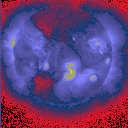
Active region NOAA 9704 displayed a nearly perfect S-shape on 20 November, see the representative image below. Because such sigmoids seem to be more likely to erupt than non-sigmoids, the SXT team have standing orders to be alert for opportunities to observe them. The goal is to make complete-as-possible measurements of the 3D magnetic structure of these twisted regions, so that one day we might be able to predict flares and coronal mass ejections. The brief campaign to observe the active region known as NOAA 9704 is the topic of this week's brief nugget.

Not With a Bang, but a Whimper
The Target of Opportunity campaign was declared on 21 November, and apparently just in time: the region produced an eruptive flare only about seven or eight hours later. This eruption was fairly subtle, with a brightening in X-rays that registered only C4.7 in the GOES classification; the flare was also quite slow in the sense that the initial increase in X-ray brightness took almost three hours. (See previous nuggets about "slow LDEs": [1], [2].) Nevertheless, the event spawned a possibly geoeffective halo CME.
Two movies are linked below, both from SXT. The first is based on the full-Sun images, and shows the slowing expanding plasmas surrounding the active region. The movie is provided in two different color schemes, to emphasize different parts of the structure. The second movie comes from the partial-Sun images, and shows the rearrangement in the middle part of the active region. Although the flare is neither cataclysmic nor particularly impulsive, the images are interesting nonetheless.
|
Wide field of view -- Red |
|
Wide field of view -- Not red |
|
Smaller field of view |
Bigger Eruptions
Later in the week the region produced more flares, and this time they were certainly more impressive: M1.2 and M9.9 in the GOES classification (see the plot here). Radio bursts were detected, and a large flux of energetic protons was observed at Earth. Unfortunately, a glitch prevented SXT from making images of these later, bigger flares; but a movie of the M9.9 flare from SOHO/EIT is shown below.

The movie actually shows two flares -- the first, smaller (M3.8) one near
the west limb is in active region NOAA 9698, and the second, larger one is
the M9.9 flare in sigmoid active region 9704. Both these flares produced
halo CMEs, according to the SOHO
experts (although the email contains a typo, attributing the bigger flare
to the wrong region).
Conclusion
We are quite interested in these sigmoidal active regions, and the twisted magnetic fields that define their character. We'll keep looking at them, trying to improve the statistics regarding their likelihood of erupting. But in the meantime, we hope to enjoy the occasional light show that they help to produce.